Better habitat for bees
In general, herbs and garden perennials are good for bees, while most annual bedding plants are less attractive to them.

Better habitat for bees
- Annuals attractive to bees
- Herbaceous perennials attractive to bees
- Shrubs attractive to bees
- Trees attractive to bees
- Wind-pollinated trees attractive to bees
- Wildflowers attractive to bees
Annuals attractive to bees
In general, herbs and garden perennials are good for bees, while most annual bedding plants are less attractive to them. Annual flowers like impatiens are readily available at the garden center, but most have been bred for showy flowers or vigorous growth and do not produce enough pollen and nectar to be good food plants for bees or butterflies. Some annuals such as marigold and moss rose are valuable for pollinators and these provide summer-long pollen and nectar.
Below are some annuals that are good food plants for pollinators. Please note that some of these, like garden heliotrope, lantana and pentas, are considered annuals in northern states but are perennials in more southern states. Because some cultivars may be more attractive to pollinators than other cultivars in the same species, you may want to try several cultivars and observe which ones attract the most bees.
|
Annuals attractive to bees table |
|
|---|---|
|
Common name |
Genus species |
|
Ageratum |
Ageratum houstonianum |
|
Anise-scented sage |
Salvia guaranitica |
|
Aster |
Callistephus chinensis |
|
Baby’s breath |
Gypsophila paniculata |
|
Beeblossom |
Gaura lindheimeri, Gaura spp. |
|
Bidens |
Bidens laevis |
|
Black-eyed Susan or |
Rudbeckia hirta |
|
Bluestar |
Amsonia illustris, other native Amsonia spp. |
|
Blue-eyed grass |
Sisyrinchium lucerne |
|
Blue salvia |
Salvia farinacea |
|
Borage or starflower |
Borago officinalis |
|
Calendula |
Calendula officinalis |
|
Calibrachoa |
Calibrachoa spp. |
|
Campion |
Lychnis chalcedonica, |
|
Catnip or catmint |
Nepeta sp. |
|
Chives |
Allium altaicum, A. ampeloprasum, A. cernum, etc. |
|
Clary sage |
Salvia sclarea (biennial) |
|
Cockscomb or woolflower |
Celosia plumose, argentia, pristada |
|
Common lantana |
Lantana camara |
|
Common sunflower |
Helianthus annuus |
|
Cornflower |
Centaurea cyanus |
|
Cosmos |
Cosmos bipinnatus |
|
Crane’s bill |
Geranium bicknellii, G. x cantabrigiense, G. himalayense, |
|
Dahlia (open types) |
Dahlia cv. |
|
Dead-nettle |
Lamium album, L. amplexicaule, L. galeobdolon, L. purpureum |
|
Dianthus |
Dianthus barbatus, D. giganteus |
|
Garden heliotrope |
Heliotrope arborescens |
|
Gentians |
Gentiana andrewsii, G. clausa, G. dahurica |
|
Lantana |
Lantana camara |
|
Lobelia |
Lobelia cardinalis, |
|
Marigold |
Tagetes spp. |
|
Mignonette |
Reseda odorata |
|
Moss rose |
Portulaca grandiflora |
|
Nasturtium |
Tropaeolum |
|
Oxeye |
Heliopsis helianthus |
|
Pentas |
Pentas spp. |
|
Pineapple sage |
Salvia elegans |
|
Rattlesnake master, Sea holly or Eryngo |
Eryngium bourgatii, |
|
Red-hot poker |
Kniphofia typhoides |
|
Salvia |
Salvia spp. |
|
Snapdragon |
Antirrhinum majus |
|
Sneezeweed |
Helenium autumnale |
|
Spider flower or |
Cleome hassleriana, C. lutea, |
|
Sunflowers |
Helianthus annuus, H. divaricatus, H. maximiliani, H. mollis, |
|
Sweet William (biennial in southern parts of north central region) |
Dianthus barbatus |
|
Sweet alyssum |
Lobularia maritima |
|
Verbena |
Verbena bonariensis, V. hybrida, V. hastata, V. stricta, V. urticifolia |
|
Vervain |
Verbena bonariensis |
|
Yellowcress |
Rorippa palustris, R. sylvestris |
|
Zinnia |
Zinnia elegans |
Herbaceous perennials attractive to bees
Researchers have identified that perennial flowers tend to be far more attractive to bees than annuals. Many different types of perennials are good for bees, from showy flowers to herbs. Herb gardens are an excellent resource for bees because they flower over a long period of time, and herbs grow fairly large and produce lots of flowers. The perennials and herbs listed below can be purchased from nurseries and garden centers in the North Central United States.
Because species and cultivars vary in cold-hardiness, be sure to check the acceptable hardiness zones listed on the plant label and match it to the USDA Plant Hardiness Zone where you live. Some of the plants listed below are also available as seeds in commercial “wildflower” mixes. If you are looking for native wildflower seed, a good source of information is the Xerces Society, which gives a list of plants and a supplier for each region.
|
Herbaceous perennials attractive to bees |
|
|---|---|
|
Common name |
Genus species (scientific name) |
|
Allium (many varieties) |
Allium |
|
Anise hyssop |
Agastache foeniculum |
|
Aromatic aster |
Symphyotrichum oblongifolium |
|
Aster |
Symphyotrichum |
|
Astilbe, false spirea |
Astilbe spp. |
|
Basil, sweet basil (annual) |
Ocimum basilicum |
|
Bee balm |
Monarda spp. |
|
Bellflower |
Campanula spp. |
|
Betony |
Stachys monieri |
|
Bigleaf ligularia |
Ligularia dentate |
|
Black-eyed Susan, coneflower |
Rudbeckia spp. |
|
Blanket flower |
Gaillardia |
|
Blazing star |
Liatris spicata |
|
Butterfly bush |
Buddleja or Buddleia spp. |
|
Butterfly weed |
Asclepias tuberosa |
|
Calamint |
Calamintha nepeta |
|
Cardoon |
Cynara cardunculus |
|
Carolina lupine |
Thermopsis villosa |
|
Catmint |
Nepeta spp. |
|
Chrysanthemum |
Chrysanthemum |
|
Chocolate flower |
Berlandiera lyrata |
|
Clematis |
Clematis spp. |
|
Common poppy, |
Papaver rhoeas |
|
Common yarrow |
Achillea millefolium |
|
Coral bells |
Heuchera spp. |
|
Cornflower |
Centaurea spp. |
|
Crown vetch |
Securigera (= Coronilla) varia |
|
Cut-leaf mallow |
Malva alcea |
|
Eryngo, rattlesnack master (various names) |
Eryngium spp. |
|
English ivy |
Hedera sp. |
|
Fennel |
Foeniculum vulgare |
|
Foxglove or beardtongues |
Penstemon spp. |
|
Garden speedwell |
Veronica longifolia |
|
Globe thistle |
Echinops ritro |
|
Glory-of-the-snow |
Chinodoxa |
|
Hardy geranium, |
Geranium ibericum x |
|
Hosta |
Hosta spp. |
|
Hyssop (naturalized in North America) |
Hyssopus officinalis |
|
Inula, Himalayan elecampane |
Inula royleana |
|
Japanese anemone |
Anemone hupehensis ‘Robutissima’ |
|
Large-leaved aster |
Eurybia macrophylla |
|
Lavender |
Lavandula |
|
Lemon balm |
Melissa officinalis |
|
Leucanthemella |
Leucanthemella serotine |
|
Lupine |
Lupinus spp. |
|
Mints |
Mentha spp. |
|
Mullein or velvet plant |
Verbascum |
|
Narrow-leaved foxtail lily |
Eremurus stenophyllus |
|
New England aster |
Symphyotrichum novae-angliae |
|
Ornamental onion, garlic, chives, leek, scallion |
Allium spp., including Allium ‘mellenium’ and ‘christophii’ |
|
Oregano |
Origanum vulgare |
|
Pachysandra |
Pachysandra terminalis |
|
Parasol whitetop |
Doellingeria umbellate |
|
Pentas |
Pentas spp. |
|
Peony |
Paeonia spp. |
|
Pincushion flower |
Scabiosa caucasica |
|
Purple burkheya |
Berkheya purpurea |
|
Purple coneflower |
Echinacea purpurea |
|
Rosemary |
Rosmarinus officinalis |
|
Russian sage |
Perovskia atriplicifolia |
|
Salvia |
Salvia ‘Victoria blue’, Salvia nemorosa ‘Black and Blue’, others |
|
Sea holly |
Eryngium maritimum |
|
Sedum |
Sedum spp. |
|
Sedum, stonecrop |
Hylotelephium spectabile and telephium and cvs. |
|
Snakeroot |
Cimicifuga famose |
|
Sneezeweed |
Helenium |
|
Squill |
Drimia maritima |
|
Stiff-leaved aster |
Ionactus linariifolius |
|
Striped squill |
Punchkinia |
|
Stokes aster |
Stokesia laevis |
|
Sunflower |
Helianthus |
|
Swamp milkweed |
Asclepias incarnata |
|
Sweet alyssum |
Lobularia maritima |
|
Sweet clover |
Melilotus spp. |
|
Thyme |
Thymus spp. |
|
Tickseed |
Coreopsis |
|
Trout lily |
Erythronium americanum |
|
White wood aster |
Eurybia divarcata |
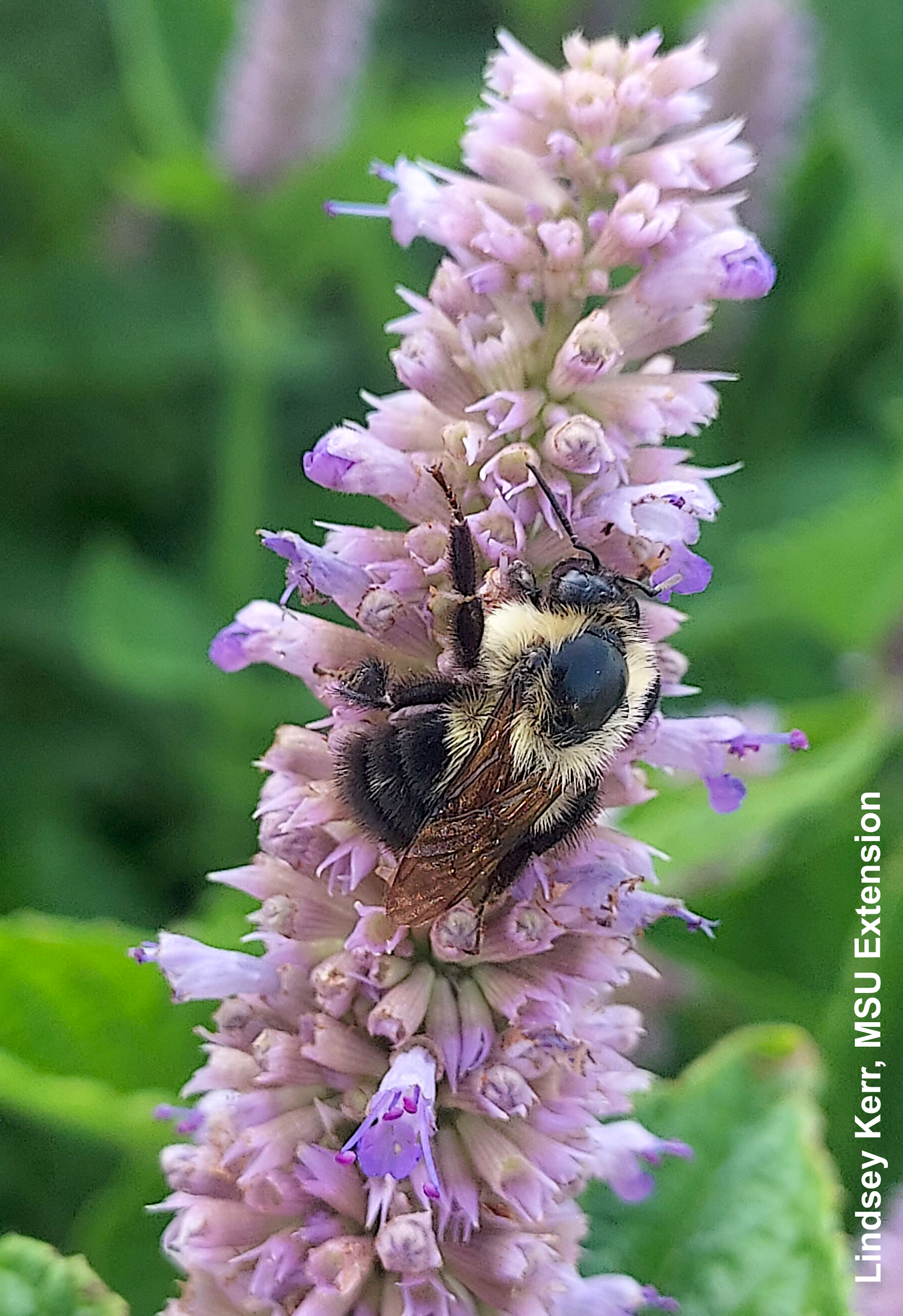
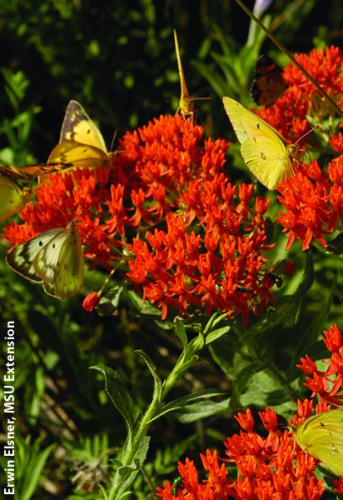


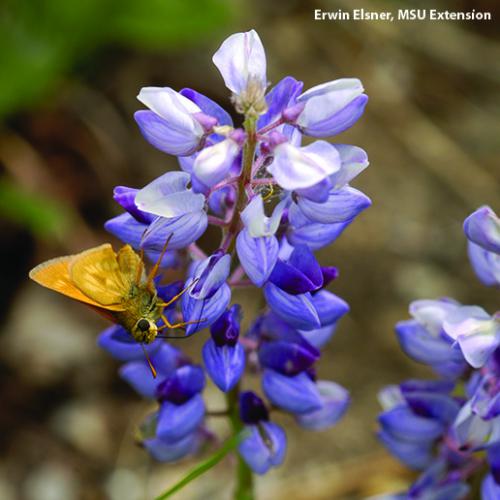
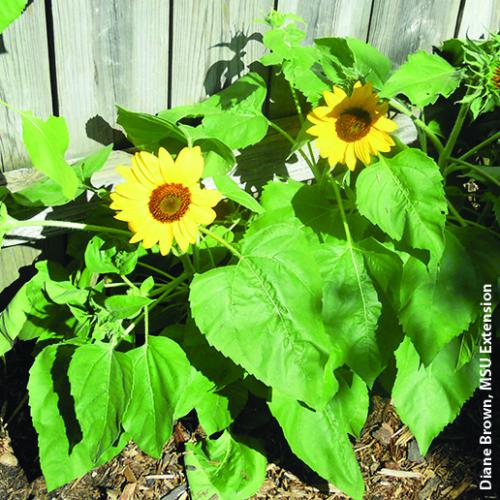
Shrubs attractive to bees
Flowering shrubs can be an excellent food source for bees because they tend to grow larger than herbaceous perennials, and therefore produce a larger number of flowers. Some species, like Rosa rugosa, bloom all summer.
|
Shrubs attractive to bees |
|
|---|---|
|
Common name |
Genus species (scientific name) |
|
Black chokeberry |
Aronia melanocarpa |
|
Bottlebrush buckeye |
Aesculus parviflora |
|
Buttonbush |
Cephalanthus occidentalis |
|
Common witch-hazel |
Hamamelis virginiana |
|
Cotoneaster |
Cotoneaster |
|
Dwarf fothergilla |
Fothergilla gardenia |
|
Eastern ninebark |
Physocarpos opulifolius |
|
Elderberry |
Sambucus spp. |
|
False indigo |
Amorpha fruticosa |
|
Flowering quince |
Chaenomeles spp. |
|
Fuzzy deutzia |
Deutzia scabra |
|
Highbush blueberry |
Vaccinium corymbosum |
|
Holly: American, box-leaved, Merserve hybrid, winterberry |
Ilex spp. |
|
Japanese tree lilac |
Syringa reticulata |
|
Lacecap hydrangea |
Hydrangea macrophylla |
|
Mockorange |
Philadelphus coronarius |
|
Ninebark |
Physocarpus opulifolius |
|
Panicle hydrangea |
Hydrangea paniculate (many cultivars) |
|
Potentilla (bush cinquefoil) |
Potentilla fruiticosa |
|
Privet |
Ligustrum vulgare |
|
Pussy willow |
Salix discolor |
|
Raspberry, blackberries |
Rubus spp. |
|
St. Johns-wort |
Hypericum spp. |
|
Silky dogwood, gray dogwood, redosier dogwood |
Cornus spp. |
|
Spicebush |
Lindera benzoin |
|
Spirea |
Spiraea spp. |
|
Staghorn sumac |
Rhus typhina |
|
Sumacs |
Rhus spp. |
|
Summersweet, sweet pepperbush |
Clethra alnifolia |
|
Viburnums |
Viburnum spp. |
|
White fringe-tree or American yellowwood |
Cladrastis kentukea |
|
Wild prairie rose |
Rosa arkansana |
|
Winter honeysuckle |
Lonicera fragrantissima |
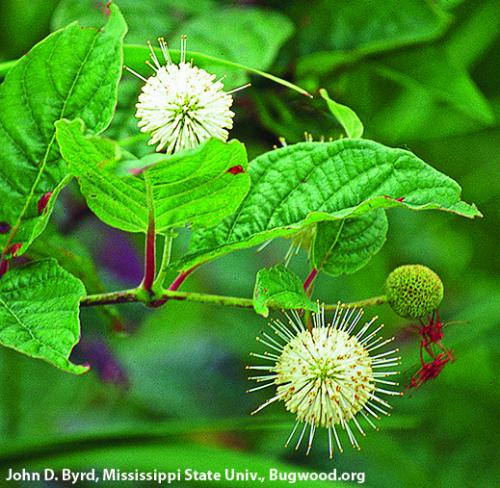
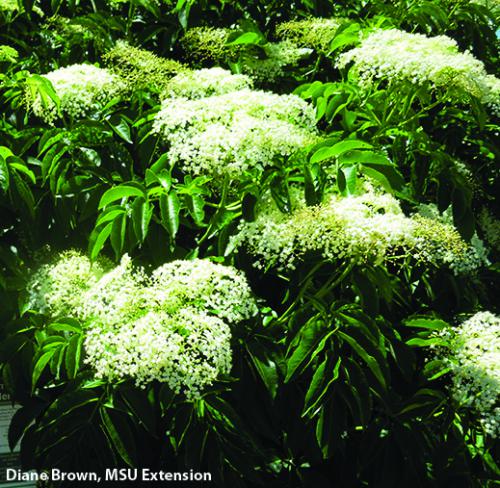

Trees attractive to bees
Flowering trees are critical to providing an ample food source for bees because of their large size and thousands of flowers. A blooming linden or black locust produces so much pollen and nectar that it dwarfs the amount provided by most garden flowers in comparison.
However, most trees only bloom for two to three weeks, so a succession of trees that bloom from early spring through summer is very helpful to bees. Trees in the North Central United States that are frequently mentioned as good food plants for bees are listed in the following table.
|
Trees attractive to bees |
||
|---|---|---|
|
Common name |
Genus species (scientific name) |
Bloom |
|
Eastern redbud |
Cercis canadensis |
April |
|
Red maple |
Acer rubrum |
April |
|
Alternate-leaved, pagoda or green osier dogwood |
Cornus alternifolia |
May |
|
Black tupelo, blackgum |
Nyssa sylvatica |
May |
|
Cherry, peach, plum, almond |
Prunus spp. (many) |
May |
|
Crabapple, apple |
Malus spp. (many) |
May |
|
Hawthorn |
Crataegus spp. (many) |
May |
|
Winter king hawthorn |
Crataegus viridis |
May |
|
Red horse chestnut |
Aesculus X carnea |
May |
|
Serviceberry |
Amelanchier spp. |
May |
|
Willow |
Salix spp. |
May |
|
Honey locust |
Gleditsia triacanthos |
May to early June |
|
Black locust |
Robinia pseudoacacia |
Late May-early June |
|
Catalpa |
Catalpa speciosa |
June |
|
Linden, basswood |
Tilia spp. |
June |
|
Tulip-tree |
Liriodendron tulipifera |
June |
|
Amur maackia |
Maackia amurensis |
July-August |
|
Bee-bee tree |
Tetradium (Evodia) daniellii |
July-August |
|
Japanese sophora, Japanese pagoda |
Sophora japonica |
July-September |
|
Seven sons tree |
Heptacodium miconioides |
August-September |
Source: Lovell 1926, Pellet 1947, Oertel 1980, Tew 2006,
Mader et al. 2011, Mach and Potter 2016
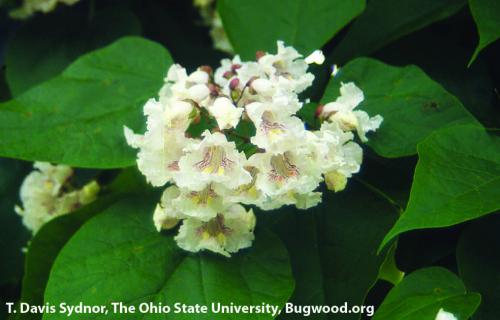
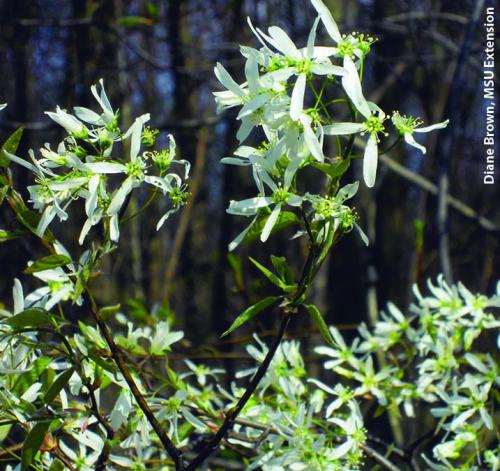
Wind-pollinated trees attractive to bees
Wind-pollinated trees do not produce nectar, but bees may take advantage of them as an abundant source of pollen. Pines, spruces and nearly all gymnosperms are not usually visited by bees unless it is to gather sap used for propolis, a sticky substance used to fill crevices and seal hives. However, several genera of wind-pollinated angiosperms are routinely visited by bees to collect pollen.
The most frequently visited wind-pollinated trees are listed in the following table. Red maple and willow are listed in both tables because they are wind-pollinated trees that are also considered important pollen or nectar sources for bees. Pollen from the wind-pollinated trees may be collected by bees because of a favorable nutritional value, the large amount of pollen produced, or because it is available at times when other food sources are scarce.
|
Wind-pollinated trees attractive to bees |
||
|---|---|---|
|
Common name |
Genus species (scientific name) |
Attractiveness to bees1 |
|
Ash |
Fraxinus spp. |
Somewhat attractive |
|
Birch |
Betula spp. |
Somewhat attractive |
|
Elm |
Ulmus spp. |
Very attractive |
|
Hickory |
Carya spp. |
Somewhat attractive |
|
Oak |
Quercus spp. |
Very attractive |
|
Poplar |
Populus spp. |
Very attractive |
|
Maple |
Acer spp. |
Highly attractive |
|
Willow |
Salix spp. |
Highly attractive |
Source: Kraemer and Favi. 2005, MacIvor et al. 2014, Oertel 1980
1Level of attractiveness in this table is rated by number of reports of bees using pollen, level of bee activity, diversity of bee species observed and amount of pollen found in hives or nests.
Wildflowers attractive to bees
Wildflower mixes often contain seed of several of the attractive perennials listed in this table. A good source for native wildflower seed is the Xerces Society, which gives a list of plants and a supplier for each region (http://www.xerces.org/pollinator-seed/). Another list of native plants and wildflowers available from nurseries and seed companies maintained by the American Horticultural Society is organized by state (https://www.ahsgardening.org/gardening-resources/societies-clubs-organizations/native-plant-societies). MSU Extension publication E2973, “Attracting Beneficial Insects with Native Flowering Plants,” provides photos and bloom time for many of the native flowers listed below. This publication is available for purchase at shop.msu.edu. Wildflowers described in E2973 are marked with an asterisk (*) in the following table.
|
Wildflowers attractive to bees |
|
|---|---|
|
Common name |
Genus species (scientific name) |
|
American vervain, blue vervain |
Verbena hastata* |
|
Aromatic aster |
Symphyotrichum oblongifolium* |
|
Canadian milkvetch |
Astragalus canadensis* |
|
Clover |
Melilotus spp. |
|
Clover |
Trifolium spp. |
|
Coneflower |
Ratibida columnifera* |
|
Culver’s root |
Veronicastrum virginicum* |
|
Cup plant |
Silphium perfoliatum* |
|
Golden alexanders |
Zizia aurea* |
|
Goldenrod |
Oligoneuron spp. |
|
Goldenrod |
Solidago speciosa |
|
Great blue lobelia |
Lobelia siphilitica |
|
Horsemint, spotted beebalm |
Monarda punctata* |
|
Joe-Pye weed |
Eupatorium fistulosum* |
|
Late figwort |
Scrophularia marilandica* |
|
Meadowsweet (shrub) |
Spirea alba* |
|
Missouri ironweed |
Vernonia missurica* |
|
Mountain mints |
Pycanthemum spp.* |
|
Native milkweeds |
Asclepias spp.* |
|
Naturalized asters |
Aster spp. |
|
Nodding wild onion |
Allium cernuum* |
|
Obedient plant, false dragonhead |
Physostegia virginiana* |
|
Pale Indian plantain |
Cacalia atriplicifolia* |
|
Penstemon, hairy beardtongue |
Penstemon hirsutus* |
|
Prairie blazing star |
Liatris pycnostachya |
|
Rattlesnake master, eryngo |
Eryngium spp. |
|
Riddell’s goldenrod |
Solidago riddellii* |
|
Rough blazing star |
Liatris aspera |
|
Rough oxeye, false sunflower |
Heliopsis helianthoides |
|
Showy milkweed |
Asclepias speciosa |
|
Smooth aster |
Aster laevis* |
|
Thimbleweed herbaceous perennial |
Anemone cylindrica* |
|
White wild indigo, false indigo |
Baptisia alba |
|
Wild quinine, American feverfew |
Parthenium integrifolium |
|
Yellow coneflower |
Ratibida pinnata* |
|
Yellow giant hyssop |
Agastache nepetoides* |
|
Weeds |
|
|
Chickweed |
Stellaria media |
|
Clover |
Trifolium spp. |
|
Dandelion |
Taraxacum officiniale |
|
Knapweed (feral) |
Centaurea montana |
|
Smartweed |
Polygonum sp. |
*Wildflowers known to attract beneficial insects and described in MSUE publication E2973.
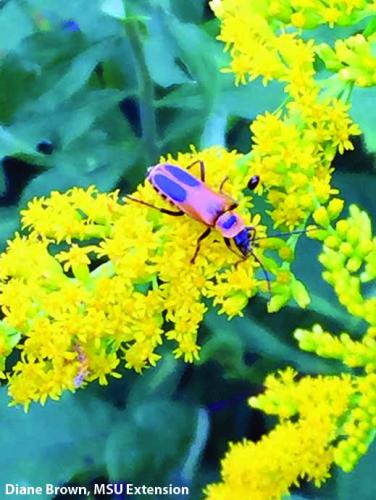
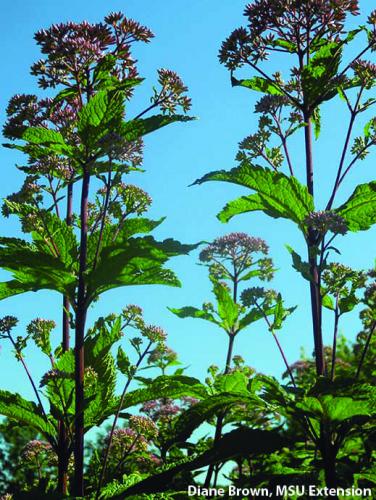
Read the next article in this publication series: Landscape plants and wildflowers attractive to butterflies for nectar feeding
Or return to the beginning of this publication: How to protect and increase pollinators in your landscape



 Print
Print Email
Email





